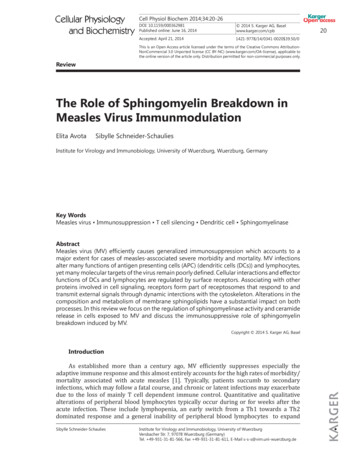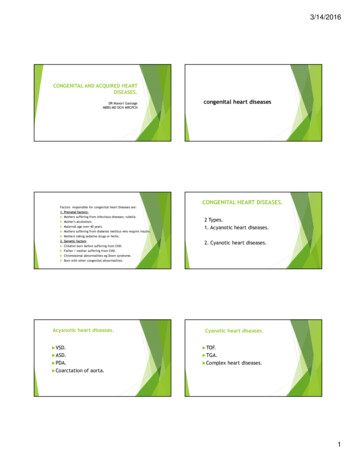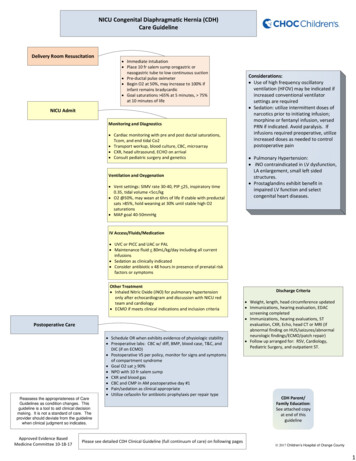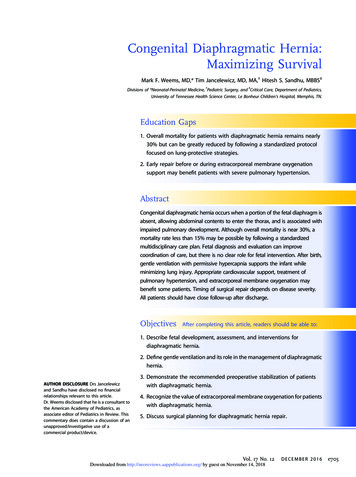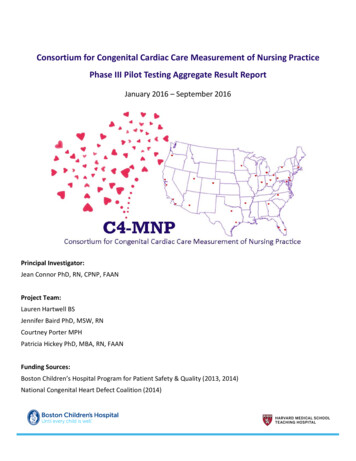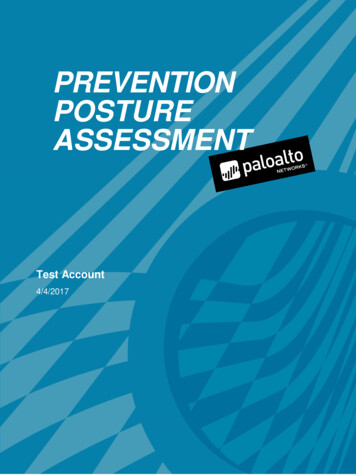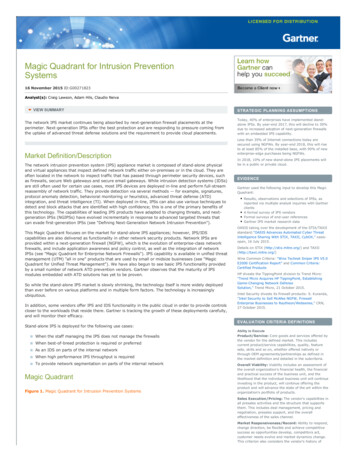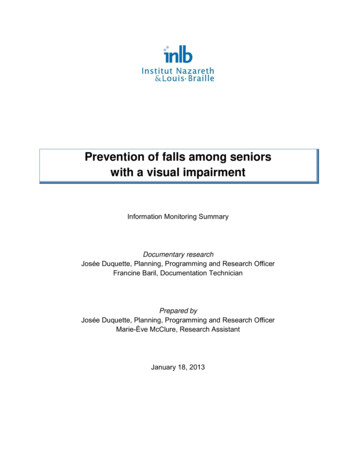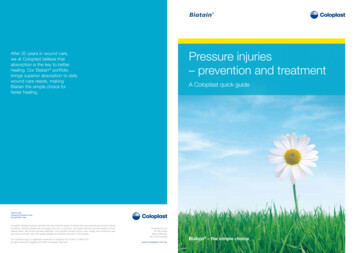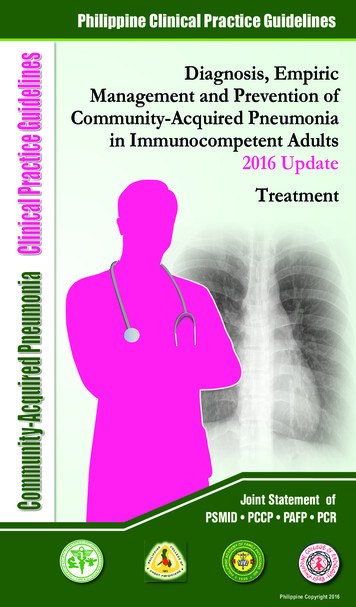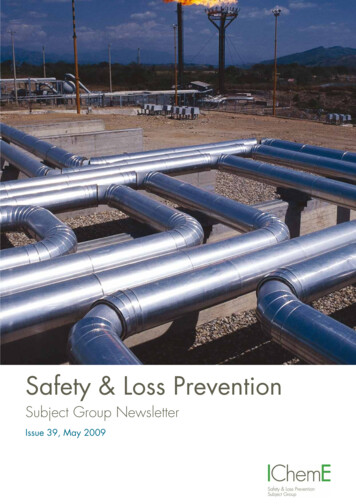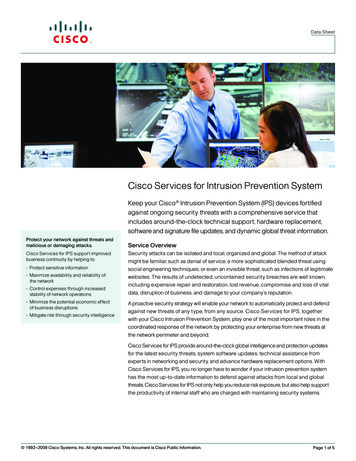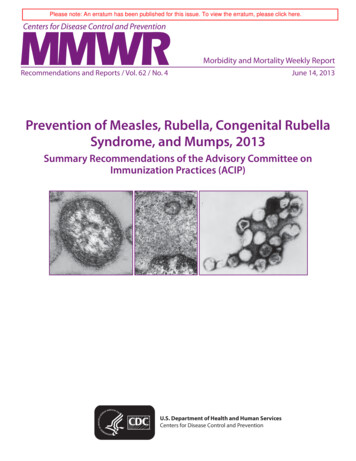
Transcription
Please note: An erratum has been published for this issue. To view the erratum, please click here.Morbidity and Mortality Weekly ReportRecommendations and Reports / Vol. 62 / No. 4June 14, 2013Prevention of Measles, Rubella, Congenital RubellaSyndrome, and Mumps, 2013Summary Recommendations of the Advisory Committee onImmunization Practices (ACIP)U.S. Department of Health and Human ServicesCenters for Disease Control and Prevention
Recommendations and ReportsCONTENTSIntroduction.2Methods.2Background and Epidemiology of Measles.2Background and Epidemiology of Rubella andCongenital Rubella Syndrome.4Background and Epidemiology of Mumps.6Vaccines for Prevention of Measles, Rubella, and Mumps.7Vaccine Dosage, Administration, and Storage. 12Contraindications and Precautions. 12Safety of MMR and MMRV Vaccine. 14Immune Globulin for Prevention of Measles. 17Evidence of Immunity. 18Rationale for Measles, Rubella, and Mumps Vaccination. 20CDC Adoption of ACIP Recommendations for MMWRRecommendations and Reports, MMWR Policy Notes, andImmunization Schedules (Child/Adolescent, Adult)ACIP is chartered as a federal advisory committee to provideexpert external advice and guidance to the Director of theCenters for Disease Control and Prevention (CDC) on useof vaccines and related agents for the control of vaccinepreventable diseases in the civilian population of the UnitedStates. Recommendations for routine use of vaccines inchildren and adolescents are harmonized to the greatestextent possible with recommendations made by the AmericanAcademy of Pediatrics (AAP), the American Academy ofFamily Physicians (AAFP), and the American College ofObstetricians and Gynecologists (ACOG). Recommendationsfor routine use of vaccines in adults are harmonized withrecommendations of AAFP, ACOG, and the American Collegeof Physicians (ACP). ACIP recommendations adopted by theCDC Director become agency guidelines on the date publishedin the Morbidity and Mortality Weekly Report (MMWR).Recommendations for Vaccination for Measles,Rubella, and Mumps. 20Recommendations during Outbreaks of Measles,Rubella, or Mumps. 23Future Directions. 25Acknowledgments. 25References. 25Front cover photos: (Left) A thin-section transmission electron micrograph (TEM) that shows the ultrastructural appearance of a single virus particle, or “virion,” ofmeasles virus. (Center) A transmission electron micrograph (TEM) that shows the presence of numerous paramyxovirus virions, which in this instance, were responsiblefor a case of the mumps. (Right) A transmission electron micrograph (TEM) that shows a number of rubella virions.The MMWR series of publications is published by the Office of Surveillance, Epidemiology, and Laboratory Services, Centers for Disease Control and Prevention (CDC),U.S. Department of Health and Human Services, Atlanta, GA 30333.Suggested Citation: Centers for Disease Control and Prevention. [Title]. MMWR 2013;62(No. RR-#):[inclusive page numbers].Centers for Disease Control and PreventionThomas R. Frieden, MD, MPH, DirectorHarold W. Jaffe, MD, MA, Associate Director for ScienceJames W. Stephens, PhD, Director, Office of Science QualityDenise M. Cardo, MD, Acting Deputy Director for Surveillance, Epidemiology, and Laboratory ServicesStephanie Zaza, MD, MPH, Director, Epidemiology and Analysis Program OfficeMMWR Editorial and Production StaffRonald L. Moolenaar, MD, MPH, Editor, MMWR SeriesChristine G. Casey, MD, Deputy Editor, MMWR SeriesTeresa F. Rutledge, Managing Editor, MMWR SeriesDavid C. Johnson, Lead Technical Writer-EditorDenise Williams, MBA, Project EditorMartha F. Boyd, Lead Visual Information SpecialistMaureen A. Leahy, Julia C. Martinroe,Stephen R. Spriggs, Terraye M. StarrVisual Information SpecialistsQuang M. Doan, MBA, Phyllis H. KingInformation Technology SpecialistsMMWR Editorial BoardWilliam L. Roper, MD, MPH, Chapel Hill, NC, ChairmanMatthew L. Boulton, MD, MPH, Ann Arbor, MITimothy F. Jones, MD, Nashville, TNVirginia A. Caine, MD, Indianapolis, INRima F. Khabbaz, MD, Atlanta, GABarbara A. Ellis, PhD, MS, Atlanta, GADennis G. Maki, MD, Madison, WIJonathan E. Fielding, MD, MPH, MBA, Los Angeles, CAPatricia Quinlisk, MD, MPH, Des Moines, IADavid W. Fleming, MD, Seattle, WAPatrick L. Remington, MD, MPH, Madison, WIWilliam E. Halperin, MD, DrPH, MPH, Newark, NJJohn V. Rullan, MD, MPH, San Juan, PRKing K. Holmes, MD, PhD, Seattle, WAWilliam Schaffner, MD, Nashville, TN
Recommendations and ReportsPrevention of Measles, Rubella, Congenital Rubella Syndrome,and Mumps, 2013Summary Recommendations of the Advisory Committee onImmunization Practices (ACIP)Huong Q. McLean, PhD1Amy Parker Fiebelkorn, MSN2Jonathan L. Temte, MD3Gregory S. Wallace, MD21Marshfield Clinic Research Foundation, Marshfield, Wisconsin2Division of Viral Diseases, National Center for Immunization and Respiratory Diseases, CDC3School of Medicine and Public Health, University of Wisconsin, Madison, WisconsinSummaryThis report is a compendium of all current recommendations for the prevention of measles, rubella, congenital rubella syndrome(CRS), and mumps. The report presents the recent revisions adopted by the Advisory Committee on Immunization Practices(ACIP) on October 24, 2012, and also summarizes all existing ACIP recommendations that have been published previouslyduring 1998–2011 (CDC. Measles, mumps, and rubella—vaccine use and strategies for elimination of measles, rubella, andcongenital rubella syndrome and control of mumps: recommendations of the Advisory Committee on Immunization Practices[ACIP]. MMWR 1998;47[No. RR-8]; CDC. Revised ACIP recommendation for avoiding pregnancy after receiving a rubellacontaining vaccine. MMWR 2001;50:1117; CDC. Updated recommendations of the Advisory Committee on ImmunizationPractices [ACIP] for the control and elimination of mumps. MMWR 2006;55:629–30; and, CDC. Immunization of healthcare personnel: recommendations of the Advisory Committee on Immunization Practices (ACIP). MMWR 2011;60[No. RR-7]).Currently, ACIP recommends 2 doses of MMR vaccine routinely for children with the first dose administered at age 12 through15 months and the second dose administered at age 4 through 6 years before school entry. Two doses are recommended for adults athigh risk for exposure and transmission (e.g., students attending colleges or other post-high school educational institutions, healthcare personnel, and international travelers) and 1 dose for other adults aged 18 years. For prevention of rubella, 1 dose of MMRvaccine is recommended for persons aged 12 months.At the October 24, 2012 meeting, ACIP adopted the following revisions, which are published here for the first time. These included: For acceptable evidence of immunity, removing documentation of physician diagnosed disease as an acceptable criterionfor evidence of immunity for measles and mumps, and including laboratory confirmation of disease as a criterion foracceptable evidence of immunity for measles, rubella, and mumps. For persons with human immunodeficiency virus (HIV) infection, expanding recommendations for vaccination to allpersons aged 12 months with HIV infection who do not have evidence of current severe immunosuppression; recommendingrevaccination of persons with perinatal HIV infection who were vaccinated before establishment of effective antiretroviraltherapy (ART) with 2 appropriately spaced doses of MMR vaccine once effective ART has been established; and changingthe recommended timing of the 2 doses of MMR vaccine for HIV-infected persons to age 12 through 15 months and4 through 6 years. For measles postexposure prophylaxis, expanding recommendations for use of immune globulin administered intramuscularly(IGIM) to include infants aged birth to 6 months exposed to measles; increasing the recommended dose of IGIM forimmunocompetent persons; and recommending use of immune globulin administered intravenously (IGIV) for severelyimmunocompromised persons and pregnant women without evidence of measles immunity who are exposed to measles.As a compendium of all current recommendations for the prevention of measles, rubella, congenital rubella syndrome (CRS),and mumps, the information in this report is intended for use by clinicians as baseline guidance for scheduling of vaccinationsfor these conditions and considerations regarding vaccinationof special populations. ACIP recommendations are reviewedperiodically and are revised as indicated when new informationCorresponding preparer: Amy Parker Fiebelkorn, MSN, Division ofViral Diseases, National Center for Immunization and Respiratorybecomes available.Diseases, CDC. Telephone: 404-639-8235; E-mail: aparker@cdc.gov.MMWR / June 14, 2013Vol. 62. 41
Recommendations and ReportsIntroductionMethodsMeasles, rubella, and mumps are acute viral diseases thatcan cause serious disease and complications of disease butcan be prevented with vaccination. Vaccines for prevention ofmeasles, rubella, and mumps were licensed and recommendedfor use in the United States in the 1960s and 1970s. Becauseof successful vaccination programs, measles, rubella, congenitalrubella syndrome (CRS), and mumps are now uncommon inthe United States. However, recent outbreaks of measles (1)and mumps (2,3) have occurred from import-associated casesbecause these diseases are common in many other countries.Persons who are unvaccinated put themselves and others atrisk for these diseases and related complications.Two live attenuated vaccines are licensed and available inthe United States to prevent measles, mumps, and rubella:MMR vaccine (measles, mumps, and rubella [M-M-R II,Merck & Co., Inc.]), which is indicated routinely for personsaged 12 months and infants aged 6 months who are travelinginternationally and MMRV vaccine (measles, mumps, rubella,and varicella [ProQuad, Merck & Co., Inc.]) licensed forchildren aged 12 months through 12 years. For the purposesof this report, MMR vaccine will be used as a general termfor measles, mumps, and rubella vaccination; however, ageappropriate use of either licensed vaccine formulation can beused to implement these vaccination recommendations.For the prevention of measles, mumps, and rubella,vaccination is recommended for persons aged 12 months. Forthe prevention of measles and mumps, ACIP recommends 2doses of MMR vaccine routinely for children with the first doseadministered at age 12 through 15 months and the second doseadministered at age 4 through 6 years before school entry. Twodoses are recommended for adults at high risk for exposure andtransmission (e.g., students attending colleges or other posthigh school educational institutions, health-care personnel,and international travelers) and 1 dose for other adults aged 18 years. For prevention of rubella, 1 dose of MMR vaccineis recommended for persons aged 12 months. This reportis a compendium of all current recommendations for theprevention of measles, rubella, congenital rubella syndrome(CRS), and mumps. The report presents the recent revisionsadopted by the Advisory Committee on ImmunizationPractices (ACIP) on October 24, 2012, and also summarizesall existing ACIP recommendations that have been publishedpreviously during 1998–2011 (4–6). As a compendium of allcurrent ACIP recommendations, the information in this reportis intended for use by clinicians as guidance for scheduling ofvaccinations for these conditions and considerations regardingvaccination of special populations.Periodically, ACIP reviews available information to informthe development or revision of its vaccine recommendations.In May 2011, the ACIP measles, rubella, and mumps workgroup was formed to review and revise previously publishedvaccine recommendations. The work group held teleconferencemeetings monthly from May 2011 through October 2012.In addition to ACIP members, the work group includedparticipants from the American Academy of Family Physicians(AAFP), the American Academy of Pediatrics (AAP), theAmerican College Health Association, the Association ofImmunization Managers, CDC, the Council of State andTerritorial Epidemiologists, the Food and Drug Administration(FDA), the Infectious Diseases Society of America, theNational Advisory Committee on Immunization (Canada),the National Institute of Health (NIH), and other infectiousdisease experts (7).*Issues reviewed and considered by the work group includedepidemiology of measles, rubella, CRS, and mumps in theUnited States; use of MMR vaccine among persons withHIV infection, specifically, revaccination of persons withperinatal HIV infection who were vaccinated before effectiveantiretroviral therapy (ART); use of a third dose of MMR vaccinefor mumps outbreak control; timing of vaccine doses; use ofimmune globulin (IG) for measles postexposure prophylaxis;and vaccine safety. Recommendation options were developedand discussed by the work group. When evidence was lacking,the recommendations incorporated expert opinion of the workgroup members. Proposed revisions and a draft statement werepresented to ACIP (ACIP meeting October 2011; February andJune 2012) and approved at the October 2012 ACIP meeting.ACIP meeting minutes, including declaration of ACIP memberconflicts of interest, if any, are available at -info.html.Background and Epidemiologyof MeaslesMeasles (rubeola) is classified as a member of the genusMorbillivirus in the family Paramyxoviridae. Measles is ahighly contagious rash illness that is transmitted from personto person by direct contact with respiratory droplets orairborne spread. After exposure, up to 90% of susceptiblepersons develop measles. The average incubation period formeasles is 10 to 12 days from exposure to prodrome and 14days from exposure to rash (range: 7–21 days). Persons withmeasles are infectious 4 days before through 4 days after rash* A list of the work group appears on page 34.2MMWR / June 14, 2013Vol. 62. 4
Recommendations and Reportsonset. In the United States, from 1987 to 2000, the mostcommonly reported complications associated with measlesinfection were pneumonia (6%), otitis media (7%), anddiarrhea (8%) (8). For every 1,000 reported measles casesin the United States, approximately one case of encephalitisand two to three deaths resulted (9–11). The risk for deathfrom measles or its complications is greater for infants, youngchildren, and adults than for older children and adolescents.In low to middle income countries where malnutrition iscommon, measles is often more severe and the case-fatalityratio can be as high as 25% (12). In addition, measles can besevere and prolonged among immunocompromised persons,particularly those who have leukemias, lymphomas, or HIVinfection (13–15). Among these persons, measles can occurwithout the typical rash and a patient can shed measles virusfor several weeks after the acute illness (16–18). However, afatal measles case without rash also has been reported in anapparently immunocompetent person (19).Pregnant women also might be at high risk for severemeasles and complications; however, available evidence doesnot support an association between measles in pregnancy andcongenital defects (20). Measles illness in pregnancy mightbe associated with increased rates of spontaneous abortion,premature labor and preterm delivery, and low birthweightamong affected infants (20–23).A persistent measles virus infection can result in subacutesclerosing panencephalitis (SSPE), a rare and usually fatal neurologicdegenerative disease. The risk for developing SSPE is 4–11 per100,000 measles cases (24,25), but can be higher when measlesoccurs among children aged 2 years (25,26). Signs and symptomsof SSPE appear an average of 7 years after measles infection, butmight appear decades later (27). Widespread use of measles vaccinehas led to the virtual disappearance of SSPE in the United States, butimported cases still occur (28). Available epidemiologic and virologicdata indicate that measles vaccine virus does not cause SSPE (27).Wild type measles virus nucleotide sequences have been detectedconsistently from persons with SSPE who have reported vaccinationand no history of natural infection (24,29–34).Epidemiology of Measles during thePrevaccine EraBefore implementation of the national measles vaccinationprogram in 1963, measles occurred in epidemic cycles andvirtually every person acquired measles before adulthood (anestimated 3 to 4 million persons acquired measles each year).Approximately 500,000 persons with measles were reportedeach year in the United States, of whom 500 persons died,48,000 were hospitalized, and another 1,000 had permanentbrain damage from measles encephalitis (28).Epidemiology of Measles during theVaccine EraAfter the introduction of the 1-dose measles vaccinationprogram, the number of reported measles cases decreasedduring the late 1960s and early 1970s to approximately22,000–75,000 cases per year (Figure 1) (35,36). Althoughmeasles incidence decreased substantially in all age groups,the greatest decrease occurred among children aged 10years. During 1984 through 1988, an average of 3,750 caseswas reported each year (37). However, measles outbreaksamong school-aged children who had received 1 dose ofmeasles vaccine prompted ACIP in 1989 to recommend thatall children receive 2 doses of measles-containing vaccine,preferably as MMR vaccine (38,39). The second dose ofmeasles-containing vaccine primarily was intended to induceimmunity in the small percentage of persons who did notseroconvert after vaccination with the first dose of vaccine(primary vaccine failure).During 1989 through 1991, a major resurgence of measlesoccurred in the United States. Approximately 55,000 casesand 120 measles-related deaths were reported. The resurgencewas characterized by an increasing proportion of casesamong unvaccinated preschool-aged children, particularlyamong those residing in urban areas (40,41). Efforts toincrease vaccination coverage among preschool-aged childrenemphasized vaccination as close to the recommended age aspossible. To improve access to ACIP-recommended vaccines,the Vaccines for Children program, a federally funded programthat provides vaccines at no cost to eligible persons aged 19years, was initiated in 1993 (42).These efforts, combined with ongoing implementationof the 2-dose MMR vaccine recommendation, reducedreported measles cases to 309 in 1995 (43). During 1993,both epidemiologic and laboratory evidence suggested thattransmission of indigenous measles had been interrupted inthe United States (44,45).The recommended measles vaccination schedule changedas knowledge of measles immunity increased and as theepidemiology of measles evolved within the United States.The recommended age for vaccination was 9 months in 1963,12 mon
high risk for exposure and transmission (e.g., students attending colleges or other post-high school educational institutions, health-care personnel, and international travelers) and 1 dose for other adults aged 18 yea
